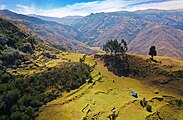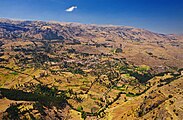Qullmay is an Inca Empire archeological site with multiple buildings along a Granite cliff, assumed to be used for both administrative and religious practices.[1][2] It is located in the Cusco Region, Anta Province, Chinchaypujio District at 3,436 m altitude.[3] Qollmay is 4 km North-West (about a 25-minute drive on dirt road) from Chinchaypujio, on the way to the campesino community of Sumaru.
 | |
| Location | Peru, Cusco Region, Anta Province, Chinchaypujio District |
|---|---|
| Region | Andes |
| Coordinates | 13°36′49.8″S 72°15′45.1″W / 13.613833°S 72.262528°W |
| Type | Temple |
| Length | 1,109 m |
| Width | 1,109 m |
| Area | 7.12Ha |
| History | |
| Cultures | Inca Empire |
| Site notes | |
| Archaeologists | Max Uhle, Ken Heffernan |
| Public access | yes |
First excavated by Max Uhle in 1905 and registered by Ken Heffernan in 1986, it has been classified in 6 sectors[3] and features about a dozen foundations, half a dozen well preserved walls and one well preserved walled-off natural cavern with Inca-style stonework inside, located within sector 1. This cavernous building is thought to be the most important one in the whole site.[1] Adjacent to it is a rock formation reminiscent of a Birth canal, speculated to be the site of fertility rituals.[citation needed]
The site is embedded within Inca-made, rectangular terraces, now overgrown with grass.[2]
-
Qollmay Archaeological Site as seen from above
-
Outside of the main cave entrance
-
Inside of the Qollmay main building cave
-
Archaeological Site as seen from above, with entire footprint of other buildings and remains.
-
The unpaved Serpentine Road from Chinchaypujio to Qollmay
-
Chinchaypujio as seen from Qollmay.
See also
editFurther reading
editReferences
edit- ^ a b "Arte rupestre Chinchaypucyo y las pinturas rupestres de Pumawasi, Provincia de Anta, Cusco Peru". www.rupestreweb.info. Retrieved 2019-08-14.
- ^ a b Silva Gonzales, José Carlos (2008). "Declaration of the Archeological Site Qollmay (Spanish)" (PDF). Geo Patrimonio Cusco. Retrieved 2019-08-14.
- ^ a b Silva Gonzales, José Carlos. "Deliminations of Qollmay" (PDF). Geopatrimonio Cusco. Retrieved 2019-08-14.





